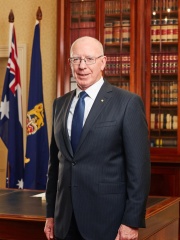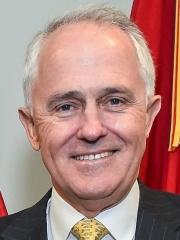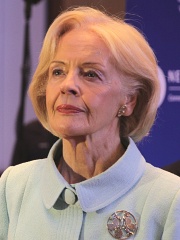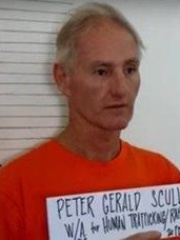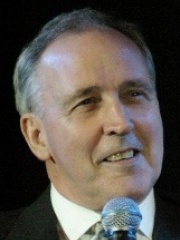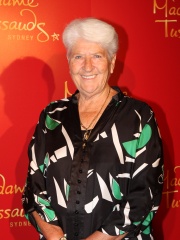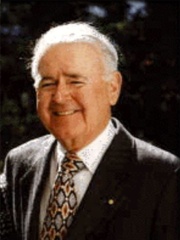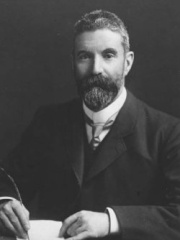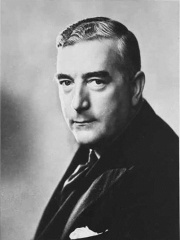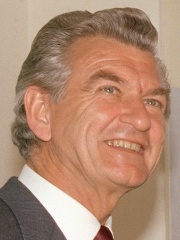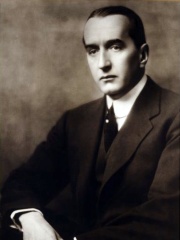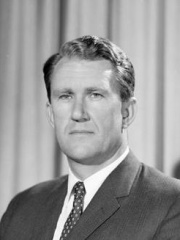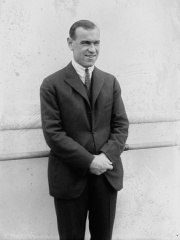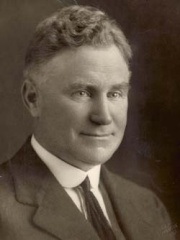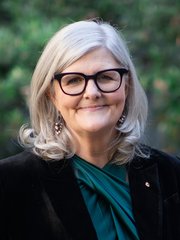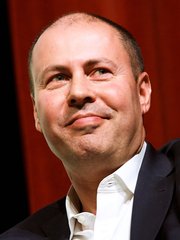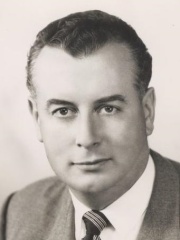
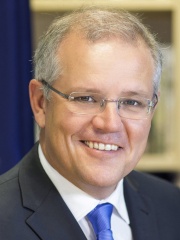
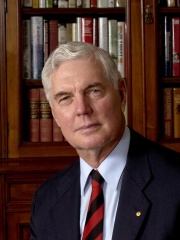
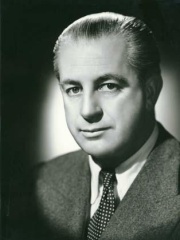
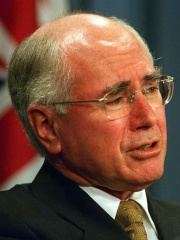
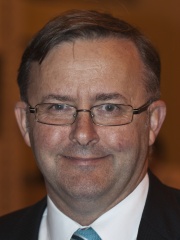
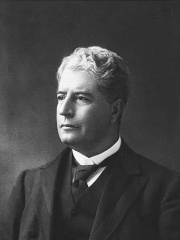
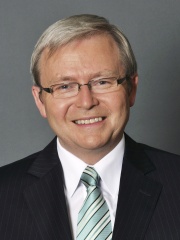
The Most Famous
POLITICIANS from Australia
This page contains a list of the greatest Australian Politicians. The pantheon dataset contains 19,576 Politicians, 55 of which were born in Australia. This makes Australia the birth place of the 63rd most number of Politicians behind Bolivia, and Venezuela.
Top 10
The following people are considered by Pantheon to be the top 10 most legendary Australian Politicians of all time. This list of famous Australian Politicians is sorted by HPI (Historical Popularity Index), a metric that aggregates information on a biography's online popularity. Visit the rankings page to view the entire list of Australian Politicians.

1. Gough Whitlam (1916 - 2014)
With an HPI of 76.74, Gough Whitlam is the most famous Australian Politician. His biography has been translated into 55 different languages on wikipedia.
Edward Gough Whitlam (11 July 1916 – 21 October 2014) was the 21st prime minister of Australia, serving from December 1972 to November 1975. To date the longest-serving federal leader of the Australian Labor Party (ALP), he was notable for being the head of a reformist and socially progressive government that ended with his controversial dismissal by the then-governor-general of Australia, Sir John Kerr, at the climax of the 1975 constitutional crisis. Whitlam remains the only Australian prime minister to have been removed from office by a governor-general. Whitlam was an air navigator in the Royal Australian Air Force for four years during World War II, and worked as a barrister following the war. He was first elected to the Australian House of Representatives in 1952, becoming a member of parliament (MP) for the division of Werriwa. Whitlam became deputy leader of the Labor Party in 1960, and in 1967, after the retirement of Arthur Calwell, was elected leader of the party and became the Leader of the Opposition. After narrowly losing the 1969 federal election to John Gorton, Whitlam led Labor to victory at the 1972 election, after 23 years of Coalition government. In its first term, the Whitlam government introduced numerous socially progressive and reformist policies and initiatives, including the termination of military conscription and the end of Australian involvement in the Vietnam War, institution of universal health care and free university education, and the implementation of legal aid programmes. With the opposition-controlled Australian Senate delaying passage of bills, Whitlam called a snap double dissolution election in May 1974 in which he won a slightly reduced majority in the House of Representatives, and picked up three Senate seats to hold equal Senate numbers to the opposition. The Whitlam government then instituted the first and only joint sitting enabled under section 57 of the Australian constitution as part of the double dissolution process. His government's second term was dominated by a declining economy suffering from the 1973 oil crisis and the 1970s global recession, as well as a political scandal known as the Loans affair, which led to the removal of two government ministers. The opposition continued to obstruct Whitlam's agenda in the Senate. In late 1975, the opposition senators refused to allow a vote on the government's appropriation bills, returning them to the House of Representatives with a demand that the government go to an election. Whitlam argued that his government, which held a clear majority in the House of Representatives, was being held to ransom by the Senate. The crisis ended in mid-November, when governor-general Sir John Kerr dismissed him from office and commissioned the opposition leader, Malcolm Fraser, as caretaker prime minister. Labor lost the subsequent election by a landslide. Whitlam stepped down as leader of the party after losing again at the 1977 election, and retired from parliament the following year. Upon the election of the Hawke government in 1983, he was appointed as Ambassador to UNESCO; he was later elected a member of the UNESCO Executive Board. He remained active into his nineties. The propriety and circumstances of his dismissal and the legacy of his government have been frequently debated in the decades since he left office. Whitlam is often ranked in the upper tier of Australian prime ministers by political experts and academics, with political journalist Paul Kelly writing in 1994 that "there is no doubt that in three years his government was responsible for more reforms and innovations than any other government in Australian history".

2. Scott Morrison (b. 1968)
With an HPI of 70.81, Scott Morrison is the 2nd most famous Australian Politician. His biography has been translated into 84 different languages.
Scott John Morrison (born 13 May 1968) is an Australian former politician who served as the 30th prime minister of Australia from 2018 to 2022. He held office as the leader of the Liberal Party and was the member of parliament (MP) for the New South Wales division of Cook from 2007 until his resignation in 2024. Morrison was born in Sydney and studied economic geography at the University of New South Wales. He worked as director of the New Zealand Office of Tourism and Sport from 1998 to 2000 and was managing director of Tourism Australia from 2004 to 2006. Morrison also was state director of the New South Wales Liberal Party from 2000 to 2004. He was first elected to the Australian House of Representatives at the 2007 election as a member of parliament (MP) for the division of Cook in New South Wales, and was quickly appointed to the shadow cabinet. After the Liberal-National coalition's victory at the 2013 election, Morrison was appointed Minister for Immigration and Border Protection in the Abbott government, where he was responsible for implementing Operation Sovereign Borders. In a reshuffle the following year, he became Minister for Social Services, where he established the Robodebt scheme. He was later promoted to the role of Treasurer in September 2015, after Malcolm Turnbull replaced Abbott as prime minister. In August 2018, Home Affairs Minister Peter Dutton unsuccessfully challenged Turnbull for the leadership of the Liberal Party. Leadership tensions continued, and the party voted to hold a second leadership ballot days later, with Turnbull choosing not to stand. In that ballot, Morrison was seen as a compromise candidate and defeated both Dutton and Foreign Minister Julie Bishop to become party leader and thus prime minister in August 2018. Morrison won a second term after leading the Coalition to an upset victory in the 2019 election. Morrison's government passed the stage three tax cuts and responded to the COVID-19 pandemic in Australia. Under his leadership, the National Cabinet was established, and Australia received praise during 2020 for being one of the few Western countries to successfully suppress the virus, though the slow initial pace of the COVID-19 vaccination rollout was criticised. Morrison would be involved in several scandals and controversies as prime minister, including his decision to take a holiday during Australia's 2019–20 bushfire season and his government's response to the disaster, his response to the 2021 Parliament sexual misconduct allegations and 2022 Eastern Australia floods and his perceived inaction on climate change. In foreign policy, Morrison oversaw the signing of the AUKUS security pact and increased tensions between Australia and China and Australia and France. Morrison directed logistical support to Ukraine as part of the international effort against Russia in the wake of the 2022 Russian invasion of Ukraine. The government was defeated at the 2022 election and Morrison stepped down as leader of the Liberal Party; Peter Dutton was elected unopposed to replace him. After leaving office, Morrison became involved in a scandal after it was revealed that he had secretly held several ministerial positions while serving as prime minister, which led to Parliament passing a censure motion against him. He resigned from Parliament on 28 February 2024, and has subsequently worked as an advisor to various lobby groups and as a public speaker.

3. Michael Jeffery (1937 - 2020)
With an HPI of 66.30, Michael Jeffery is the 3rd most famous Australian Politician. His biography has been translated into 27 different languages.
Major General Philip Michael Jeffery (12 December 1937 – 18 December 2020) was a senior Australian Army officer and vice-regal representative. He was the 28th governor of Western Australia from 1993 to 2000, and the 24th governor-general of Australia, serving from 2003 to 2008. From Perth, Western Australia, Jeffery graduated from the Royal Military College, Duntroon, and served in the Malayan Emergency and the Vietnam War, being awarded the Military Cross during the latter conflict. Jeffery was at various stages commander of the Special Air Service Regiment and the 1st Division, and subsequently Deputy Chief of General Staff, before retiring from active service in 1993. After serving for seven years as Governor of Western Australia, Jeffery was appointed Governor-General of Australia in 2003, following the resignation of Peter Hollingworth. He was the first career Australian Army officer to hold the position, and was succeeded by Quentin Bryce.

4. Harold Holt (1908 - 1967)
With an HPI of 63.02, Harold Holt is the 4th most famous Australian Politician. His biography has been translated into 47 different languages.
Harold Edward Holt (5 August 1908 – 17 December 1967) was an Australian politician who served as the 17th prime minister of Australia from 1966 until his disappearance and presumed death in 1967. He held office as leader of the Liberal Party of Australia and held various ministerial positions from 1949 to 1966 in the governments of Robert Menzies and Arthur Fadden. Holt was born in Sydney and moved to Melbourne in childhood, studying law at the University of Melbourne. Before entering politics, he practised law and was a lobbyist for cinema operators. He was first elected to the House of Representatives at the 1935 Fawkner by-election, aged 27, as a member of the United Australia Party (UAP). Holt was made a minister without portfolio in 1939, when his mentor Robert Menzies became prime minister. His tenure in the ministry was interrupted by a brief stint in the Australian Army, which ended when he was recalled to cabinet following the deaths of three ministers in the 1940 Canberra air disaster. The government was defeated in 1941, sending the UAP into opposition, and he joined the new Liberal Party upon its creation in 1945. When the Liberals came to office in 1949, Holt became a senior figure in the new government. As Minister for Immigration (1949–1956), he expanded the post-war immigration scheme and relaxed the White Australia policy for the first time. He was also influential as Minister for Labour and National Service (1949–1958), where he handled several industrial relations disputes. Holt was elected deputy leader of the Liberal Party in 1956, and after the 1958 election replaced Arthur Fadden as Treasurer. He oversaw the creation of the Reserve Bank of Australia and the decimal Australian dollar, but he was blamed for a credit crunch that almost cost the Coalition the 1961 election. However, the economy soon rebounded, and Holt retained his place as Menzies' heir apparent. Holt became prime minister in January 1966, elected unopposed as Liberal leader following Menzies' retirement. He fought a general election later that year, winning a landslide victory. The Holt government continued the dismantling of the White Australia policy, amended the constitution to give the federal government responsibility for indigenous affairs, and took Australia out of the sterling area. Holt promoted greater engagement with Asia and the Pacific, and made visits to a number of East Asian countries. His government expanded Australia's involvement in the Vietnam War, and maintained close ties with the United States under President Lyndon B. Johnson. While visiting the White House, Holt proclaimed that he was "all the way with LBJ", a remark which was poorly received at home. In December 1967, Holt disappeared while swimming in rough conditions at Cheviot Beach, Victoria. He was presumed dead, although his body was never recovered; his disappearance spawned a number of conspiracy theories. Holt was the third Australian prime minister to die in office. He was succeeded by Country Party leader John McEwen on an interim basis and then by John Gorton. His death was commemorated in a number of ways, among them by the establishment of the Harold Holt Memorial Swimming Centre in Melbourne, and the Harold E. Holt Naval Communication Station in Exmouth, Western Australia.
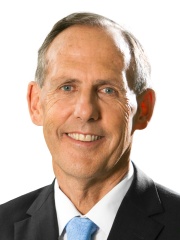
5. Bob Brown (b. 1944)
With an HPI of 62.85, Bob Brown is the 5th most famous Australian Politician. His biography has been translated into 20 different languages.
Robert James Brown (born 27 December 1944) is an Australian former politician, medical doctor and environmentalist. He was a senator and the parliamentary leader of the Australian Greens. Brown was elected to the Australian Senate on the Tasmanian Greens ticket, joining with sitting Greens Western Australia senator Dee Margetts to form the first group of Australian Greens senators following the 1996 federal election. He was re-elected in 2001 and in 2007. He was the first openly gay member of the Parliament of Australia and the first openly gay leader of an Australian political party. While serving in the Tasmanian parliament, Brown successfully campaigned for a large increase in the protected wilderness areas. Brown led the Australian Greens from the party's foundation in 1992 until April 2012, a period in which polls grew to around 10% at state and federal levels (13.1% of the primary vote in 2010). From 2002 to 2004, when minor parties held the balance of power in the Senate, Brown became a well-recognised politician. In October 2003 Brown was the subject of international media interest when he was suspended from the parliament for interjecting during an address by United States president George W. Bush. On 13 April 2012, Brown resigned as leader of the Greens and indicated his intention to resign from the Senate in June. This occurred on 15 June 2012.

6. John Howard (b. 1939)
With an HPI of 61.66, John Howard is the 6th most famous Australian Politician. His biography has been translated into 71 different languages.
John Winston Howard (born 26 July 1939) is an Australian former politician who served as the 25th prime minister of Australia from 1996 to 2007, holding office as leader of the Liberal Party of Australia. His eleven-year tenure as prime minister is the second-longest in Australian history, after that of Sir Robert Menzies. Since the death of Bob Hawke in 2019, Howard is the oldest living Australian former prime minister. Howard was born in Sydney and studied law at the University of Sydney. He was a commercial lawyer before entering parliament. A former federal president of the Young Liberals, he first stood for office at the 1968 New South Wales state election, but lost narrowly. At the 1974 federal election, Howard was elected as a member of parliament (MP) for the division of Bennelong. He was promoted to cabinet in 1977, and later in the year replaced Phillip Lynch as treasurer of Australia, remaining in that position until the defeat of Malcolm Fraser's government at the 1983 election. In 1985, Howard was elected leader of the Liberal Party for the first time, thus replacing Andrew Peacock as Leader of the Opposition. He led the Liberal–National coalition to the 1987 federal election, but lost to Bob Hawke's Labor government, and was removed from the leadership in 1989. Remaining a key figure in the party, Howard was re-elected leader in 1995, replacing Alexander Downer, and subsequently led the Coalition to a landslide victory at the 1996 federal election. In his first term, Howard introduced reformed gun laws in response to the Port Arthur massacre, and controversially implemented a nationwide value-added tax, breaking a pre-election promise. The Howard government called a snap election for October 1998, which they won, albeit with a greatly reduced majority. Going into the 2001 election, the Coalition trailed behind Labor in opinion polling. However, in a campaign dominated by national security, Howard introduced changes to Australia's immigration system to deter asylum seekers from entering the country, and pledged military assistance to the United States following the September 11 attacks. Due to this, Howard won widespread support, and his government was narrowly re-elected. In Howard's third term in office, Australia contributed troops to the War in Afghanistan and the Iraq War, and led the International Force for East Timor. The Coalition was re-elected once more at the 2004 federal election. In his final term in office, his government introduced industrial relations reforms known as WorkChoices, which proved controversial and unpopular with the public. The Howard government was defeated at the 2007 federal election, with the Labor Party's Kevin Rudd succeeding him as prime minister. Howard also lost his own seat of Bennelong at the election to Maxine McKew, becoming only the second prime minister to do so, after Stanley Bruce at the 1929 election. Following this loss, Howard retired from politics, but has remained active in political discourse. Howard's government presided over a sustained period of economic growth and a large "mining boom", and significantly reduced government debt by the time he left office. He was known for his broad appeal to voters across the political spectrum, and commanded a diverse base of supporters, colloquially referred to as his "battlers". Retrospectively, ratings of Howard's premiership have been polarised. His critics have admonished him for involving Australia in the Iraq War, his policies regarding asylum seekers, and his economic agenda. Nonetheless, he has been frequently ranked within the upper-tier of Australian prime ministers by political experts and the general public.

7. Anthony Albanese (b. 1963)
With an HPI of 60.28, Anthony Albanese is the 7th most famous Australian Politician. His biography has been translated into 70 different languages.
Anthony Norman Albanese (born 2 March 1963) is an Australian politician who has served as the 31st prime minister of Australia since 2022. He has been the leader of the Labor Party since 2019 and the member of parliament (MP) for the New South Wales division of Grayndler since 1996. Albanese was born in Sydney, attended St Mary's Cathedral College and studied economics at the University of Sydney. As a student, he joined the Labor Party and later worked as a party official and research officer before entering Parliament. Albanese was elected to the House of Representatives at the 1996 election, winning the seat of Grayndler in New South Wales. He was first appointed to the shadow cabinet in 2001 by Simon Crean and went on to serve in a number of roles, eventually becoming Manager of Opposition Business in 2006. After Labor's victory in the 2007 election, Albanese was appointed Leader of the House, and was also made Minister for Regional Development and Local Government and Minister for Infrastructure and Transport. In the subsequent leadership tensions between Kevin Rudd and Julia Gillard from 2010 to 2013, Albanese was publicly critical of the conduct of both, calling for party unity. After supporting Rudd in the final leadership ballot between the two in June 2013, Albanese was elected the deputy leader of the Labor Party and sworn in as deputy prime minister the following day, a position he held for less than three months, as Labor was defeated at the 2013 election. Following this, Albanese stood for leadership of the Labor Party against Bill Shorten in a leadership election. Although Albanese won a large majority of the membership, Shorten received more support from Labor MPs and became leader. Shorten subsequently appointed Albanese to his Shadow Cabinet. After Labor's surprise defeat in the 2019 election, Shorten resigned as leader, with Albanese becoming the only person nominated in the leadership election to replace him; he was subsequently elected unopposed as leader of the Labor Party, becoming Leader of the Opposition. He led the party to the 2022 election, where it was victorious over Scott Morrison's Liberal–National Coalition. He was sworn in on 23 May 2022. In his first term, Albanese led his government's response to Australia's cost-of-living crisis caused by the 2021–2023 inflation surge, held an unsuccessful referendum to enshrine an Indigenous Voice to Parliament in the Constitution, updated Australia's climate targets to reach carbon neutrality by 2050, made major changes to industrial relations laws, enacted the Future Made in Australia industrial policy, created the National Anti-Corruption Commission, introduced a ban on children under sixteen from using social media platforms, established the Royal Commission into the Robodebt Scheme and expanded access to paid parental leave and subsidised childcare. In foreign policy, Albanese pledged further logistical support to Ukraine to assist with the Russo-Ukrainian War, attempted to strengthen relations in the Pacific region, and oversaw an easing of tensions and trade restrictions put on Australia by China. He also administered the official commencement of the AUKUS security pact between Australia, the United States, and the United Kingdom, and navigated Australia's response to the Gaza war. Despite often scoring low approval ratings, his government was re-elected in a landslide victory in the 2025 election, resulting in one of the largest Labor governments in Australian history. In his second term, Albanese reduced university education fees, expanded programs to combat Australia's housing inaffordability crisis, set the country's first 2035 emissions reduction targets and responded to the 2025 Bondi Beach shooting.

8. Edmund Barton (1849 - 1920)
With an HPI of 60.13, Edmund Barton is the 8th most famous Australian Politician. His biography has been translated into 53 different languages.
Sir Edmund "Toby" Barton (18 January 1849 – 7 January 1920) was an Australian politician, barrister and jurist who served as the first prime minister of Australia from 1901 to 1903. He held office as the leader of the Protectionist Party, before resigning in 1903 to become a founding justice of the High Court of Australia, on which he served until his death in 1920. Barton is regarded as a founding father of Australia, a principal leader in the federation of the Australian colonies and a drafter of the Commonwealth Constitution. Barton was an early supporter of the federation of the Australian colonies, the goal of which he summarised as "a nation for a continent, and a continent for a nation". After the retirement of Henry Parkes he came to be seen as the leader of the federation movement in New South Wales. He was a delegate to the constitutional conventions, playing a key role in the drafting of a national constitution, and was one of the lead campaigners for federation in the subsequent referendums. In late 1900, despite the initial "Hopetoun Blunder", Barton was commissioned to form a caretaker government as Australia's first prime minister. His term began on 1 January 1901, the date on which federation occurred. At the first federal election in March 1901, Barton and the Protectionists won the most seats, but were well short of a majority. He was able to remain as prime minister by forming an alliance with the fledgling Australian Labor Party (ALP), which held the balance of power. The Barton government established a number of new national institutions, including the Australian Defence Force and the Commonwealth Public Service. It introduced nation-wide women's suffrage, and laid the foundations of the White Australia policy with the Immigration Restriction Act 1901. Barton left politics in 1903 to become one of the three founding members of the High Court, which his government had created. He was succeeded as prime minister by Alfred Deakin. On the court, Barton was able to shape the judicial interpretation of the constitution he had helped write.

9. Kevin Rudd (b. 1957)
With an HPI of 59.93, Kevin Rudd is the 9th most famous Australian Politician. His biography has been translated into 84 different languages.
Kevin Michael Rudd (born 21 September 1957) is an Australian diplomat and former politician who served as the 26th prime minister of Australia from 2007 to 2010 and in 2013. He held office as the leader of the Labor Party from 2006 to 2010, with a brief return to the leadership in 2013. Since 2023, Rudd has served as the 23rd ambassador of Australia to the United States. Born in Nambour, Queensland, Rudd graduated from the Australian National University with honours in Chinese studies, and is fluent in Mandarin. Before politics, he worked as a diplomat and public servant for the Queensland state government of Wayne Goss. Rudd was elected to the Australian House of Representatives at the 1998 federal election for the Queensland division of Griffith. He was promoted to the shadow cabinet in 2001 as Shadow Minister for Foreign Affairs. He assumed leadership of the Labor Party in December 2006 by defeating Kim Beazley in a leadership spill, becoming leader of the opposition. Rudd led Labor to a landslide victory at the 2007 election; his government's earliest acts included ratifying the Kyoto Protocol on climate change and delivering the first national apology to Australia's Indigenous peoples for the Stolen Generations. His government responded to the 2008 financial crisis, implementing economic stimulus packages that resulted in Australia becoming one of the only developed countries to avoid the Great Recession. Rudd's government also oversaw the establishment of the National Broadband Network (NBN), the launch of the Digital Education Revolution and Building the Education Revolution programs, dismantling WorkChoices, and withdrew Australian troops from the Iraq War. By 2010, Rudd's leadership had faltered due to a loss of support among the Labor caucus and failure to pass key legislation like the Carbon Pollution Reduction Scheme. He resigned as prime minister in June 2010 after his deputy Julia Gillard challenged him in a leadership spill. He was replaced by Gillard as prime minister, who later appointed him as Minister for Foreign Affairs in her government. Leadership tensions between Rudd and Gillard continued, leading to Rudd resigning as Foreign Minister in February 2012 to unsuccessfully challenge her for the leadership of the party. After further leadership speculation, Rudd defeated Gillard in a final leadership ballot in June 2013, becoming prime minister for the second time. However, Labor were defeated in the 2013 election, ending his second term after only two months. Rudd retired from parliament following the election, but he has stayed active in political discourse and academia, completing a DPhil at Jesus College, Oxford, in 2022. He has been involved in a number of international organizations, advocating for issues such as China–United States relations and Australian media diversity. He was appointed as Australia's ambassador to the U.S. by the Albanese government in March 2023.
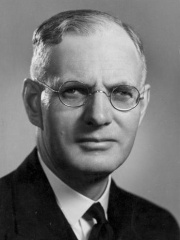
10. John Curtin (1885 - 1945)
With an HPI of 58.89, John Curtin is the 10th most famous Australian Politician. His biography has been translated into 40 different languages.
John Curtin (8 January 1885 – 5 July 1945) was an Australian politician who served as the 14th prime minister of Australia from 1941 until his death in 1945. He held office as the leader of the Australian Labor Party (ALP), having been most notable for leading the country through the majority of World War II, including all but the last few weeks of the war in the Pacific. Curtin's leadership skills and personal character were acclaimed by his political contemporaries, and he is frequently ranked as one of Australia's greatest prime ministers and political leaders. Curtin left school at the age of 13 and became involved in the labour movement in Melbourne. He joined the Labor Party at a young age and was also involved with the Victorian Socialist Party. He became state secretary of the Timberworkers' Union in 1911 and federal president in 1914. Curtin was a leader of the "No" campaign during the 1916 referendum on overseas conscription, and was briefly jailed for refusing to attend a compulsory medical examination. He moved to Perth the following year to become the editor of the Westralian Worker, and later was state president of the Australian Journalists' Association. After three unsuccessful attempts, Curtin was elected to the House of Representatives at the 1928 federal election, winning the Division of Fremantle. He is the only prime minister to have represented a constituency in Western Australia. He remained loyal to the Labor government during the party split of 1931. He lost his seat in Labor's landslide defeat at the 1931 election, but won it back in 1934. The following year, Curtin was elected party leader in place of James Scullin, defeating Frank Forde by a single vote. The party gained seats at the 1937 and 1940 elections, with the latter resulting in a hung parliament. The ALP eventually formed a minority government in October 1941, when the Fadden government lost a confidence motion. The Japanese attacks on British Malaya and Pearl Harbor occurred two months after Curtin became prime minister, and Australia entered the war against Japan. The failure of the British army and navy against Japan and bombing raids on northern Australia created the fear of an imminent Japanese invasion. Curtin realized that only a dependence upon the United States could protect Australia. Curtin led the nation's war effort and made significant decisions about how the war was conducted. He placed Australian forces under the command of the American general Douglas MacArthur, with whom he formed a close relationship. On the home front he successfully negotiated the issue of overseas conscription that had split his party during World War I. The ALP won almost two-thirds of the seats in the House of Representatives at the 1943 election, which remains a party record. Curtin died in office in July 1945, after months of ill health attributed to the stresses of the war. Many of his post-war reconstruction plans were implemented by his successor Ben Chifley, who in 1946 led the ALP to consecutive victories for the first time.
People
Pantheon has 55 people classified as Australian politicians born between 1849 and 1985. Of these 55, 28 (50.91%) of them are still alive today. The most famous living Australian politicians include Scott Morrison, Bob Brown, and John Howard. The most famous deceased Australian politicians include Gough Whitlam, Michael Jeffery, and Harold Holt. As of April 2024, 3 new Australian politicians have been added to Pantheon including Sam Mostyn, Karsten Forsterling, and Josh Frydenberg.
Living Australian Politicians
Go to all RankingsScott Morrison
1968 - Present
HPI: 70.81
Bob Brown
1944 - Present
HPI: 62.85
John Howard
1939 - Present
HPI: 61.66
Anthony Albanese
1963 - Present
HPI: 60.28
Kevin Rudd
1957 - Present
HPI: 59.93
David Hurley
1953 - Present
HPI: 57.60
Malcolm Turnbull
1954 - Present
HPI: 56.69
Quentin Bryce
1942 - Present
HPI: 56.59
Peter Scully
1963 - Present
HPI: 56.11
Paul Keating
1944 - Present
HPI: 55.54
Dawn Fraser
1937 - Present
HPI: 55.32
William Deane
1931 - Present
HPI: 55.22
Deceased Australian Politicians
Go to all RankingsGough Whitlam
1916 - 2014
HPI: 76.74
Michael Jeffery
1937 - 2020
HPI: 66.30
Harold Holt
1908 - 1967
HPI: 63.02
Edmund Barton
1849 - 1920
HPI: 60.13
John Curtin
1885 - 1945
HPI: 58.89
Alfred Deakin
1856 - 1919
HPI: 58.38
Robert Menzies
1894 - 1978
HPI: 58.04
Bob Hawke
1929 - 2019
HPI: 57.74
Stanley Bruce
1883 - 1967
HPI: 57.10
Malcolm Fraser
1930 - 2015
HPI: 57.03
Gerald Patterson
1895 - 1967
HPI: 56.71
Earle Page
1880 - 1961
HPI: 55.42
Newly Added Australian Politicians (2025)
Go to all RankingsSam Mostyn
1965 - Present
HPI: 53.89
Karsten Forsterling
1980 - Present
HPI: 34.30
Josh Frydenberg
1971 - Present
HPI: 31.66
Overlapping Lives
Which Politicians were alive at the same time? This visualization shows the lifespans of the 25 most globally memorable Politicians since 1700.

